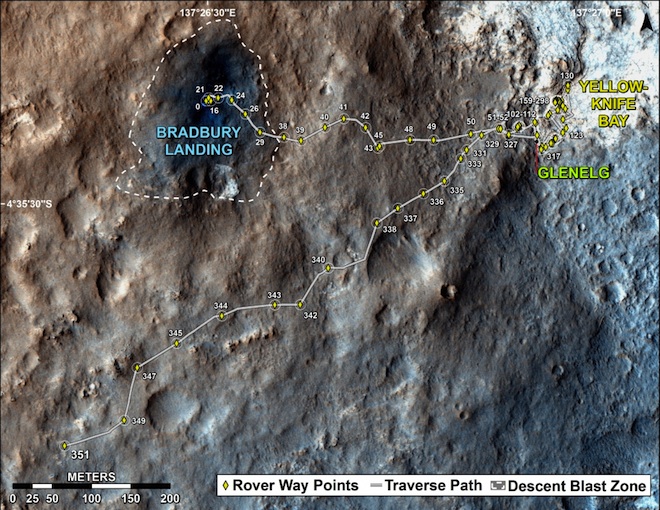Curiosity rolls into second year of mission on Mars
Some numbers on the assignment to date
In this photo provided by NASA’s JPL, this is one of the first images taken by NASA’s Curiosity rover, which landed on Mars the evening of Sunday, Aug. 5, 2012, PDT. It was taken with a “fisheye” wide-angle lens on the left “eye” of a stereo pair of Hazard-Avoidance cameras on the left-rear side of the rover. The image is one-half of full resolution. The clear dust cover that protected the camera during landing has been sprung open. Part of the spring that released the dust cover can be seen at the bottom right, near the rover’s wheel. On the top left, part of the rover’s power supply is visible. Some dust appears on the lens even with the dust cover off. The cameras are looking directly into the sun, so the top of the image is saturated. The lines across the top are an artifact called “blooming” that occurs in the camera’s detector because of the saturation. As planned, the rover’s early engineering images are lower resolution. Larger color images from other cameras are expected later in the week when the rover’s mast, carrying high-resolution cameras, is deployed. (AP Photo/NASA/JPL-Caltech)
Share
Entering Mars’ atmosphere. 7. Minutes. Of. Terror. Starts. NOW. #MSL
— Curiosity Rover (@MarsCuriosity) August 6, 2012

One year into Curiosity’s mission to Mars, NASA has released some numbers on its rover.
A sample of what it’s been up to since arriving at Bradbury Landing on a two-year hunt for signs that the red planet once hosted life—or any indication that life could, one day, survive there:
1.6: Number of kilometres the Curiousity has travelled.
190: The number of gigabits of data collected.
36,700: The number of full images.
75,000: Number of laser shots fired to check on composition of objects.
2: Number of rocks sampled and analysed.
NASA will celebrate the one-year milestone on Tuesday. It has also celebrated the mission so far in video:
From Day 1, NASA has shared mission highlights via @MarsCuriosity on Twitter. Here’s an excerpt of a feed from earlier this year: